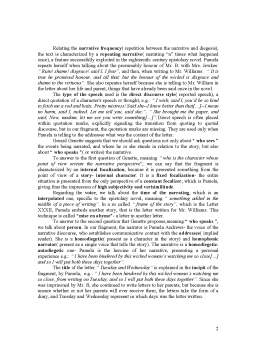Extras din referat
“Pamela, or Virtue Rewarded” is an epistolary novel written by Samuel Richardson, in two volumes, first published in 1740. Epistolary novels, that is, novels written as a series of letters, were extremely popular during the eighteenth century and it was Richardson's Pamela that made them so. Richardson claimed that he was writing "to the moment," that is, that Pamela's thoughts were recorded nearly simultaneously with her actions.
The novel tells the story of a young maid of 16, named Pamela, whose master, Mr. B., makes unwanted advances towards her. She rejects him continually, and her virtue is eventually rewarded when he shows his sincerity by proposing an equitable marriage to her. In the second part of the novel, Pamela attempts to accommodate herself to upper-class society and to build a successful relationship with him.
The fragment which I will comment is an excerpt from Letter XXXII, named “Tuesday and Wednesday”.
In terms of narrative structure, the fragment has a story( the raw material consisting of events- Pamela’s trial to convince Mr. Williams, the chaplain, through the agency of a letter addressed to him, to help her in the attempt to escape from Mr. B, who kept her as a prisoner at Lincolnshire Estate, of characters- Pamela Andrews, both a character and narrator of the story, Mr. Williams-, chaplain to Mr. B and Mrs. Jewkes, the housekeeper in Lincolnshire Estate, a woman devoted to Mr. B and the setting which is the house and respectively, the garden), and there is also a discourse (which remoldes the story material by means of different narrative techniques, how we will see further).
The form of narrative movement used, regarding duration, is mostly the scene, in the first part of the letter, because more often there are dialogued fragments, which realize conventionally the equality of time between narrative and story. This presupposes a decreased narrative speed, e.g.: “Sir, I see two tiles upon that parsley- bed; might not one cover them with mould, with a note between them, on occasion?--A good hint, said he; let that sunflower by the back- door of the garden be the place[…]”. But there are also paragraphs containing descriptive pause, through which Pamela expresses her thoughts and feelings, e.g: “So I was forced to begin. O what inventions will necessity push us upon! I hugged myself at the thought[…]”.
In the second part of the letter, the narrative movement used is the descriptive pause, when there is a zero narrative speed and the discourse time elapses on description or comment, e.g.: “I am so wretched, and ill- treated by Mrs. Jewkes, and she is so ill- principled a woman, that, as I may soon want the opportunity which the happy hint of this day affords to my hopes[…] For I see it, sir, in your looks, I hope it from your cloth, and I doubt it not from your inclination, in a case circumstanced as my unhappy one is”. There are also summarized fragments, which presupposes an increased narrative speed, e.g.: “ We then talked of the garden, how large and peasant, and the like; and sat down on the tufted slope of the fine fish- pond[…]”, “ So I went towards the pond, the maid following me, and dropt purposely my hussy[…], She went back to look, and I slipt the note between the tiles, and covered them[…]; and the maid finding the hussy, I took it, and sauntered in again[…]”.
Relating the narrative frequency( repetition between the narrative and diegesis), the text is characterized by a repeating narrative( narrating “n” times what happened once), a feature successfully exploited in the eighteenth- century epistolary novel. Pamela repeats herself when talking about the presumably honour of Mr. B. with Mrs. Jewkes: “ Ruin! shame! disgrace! said I, I fear”, and then, when writing to Mr. Williams: “ It is true he promised honour, and all that; but the honour of the wicked is disgrace and shame to the virtuous”. She also repeates herself because she is telling to Mr. William in the letter about her life and parent, things that have already been said once in the novel.
The type of the speech used is the direct discourse style( reported speech), a direct quotation of a character's speech or thought, e.g.: “ I wish, said I, you’d be so kind to fetch me a rod and baits. Pretty mistress! Said she--I know better than that[…]--I mean no harm, said I, indeed. Let me tell you, said she.”, “ She brought me the paper, and said, Now, madam, let me see you write something[…]”.Direct speech is often placed within quotation marks, explicitly signaling the transition from quoting to quoted discourse, but in our fragment, the quotation marks are missing. They are used only when Pamela is telling to the addressee what was the content of the letter.
Gerard Genette suggests that we should ask questions not only about “ who sees ” the events being narrated, and where he or she stands in relation to the story, but also about “ who speaks ”( or writes) the narrative.
Preview document
Conținut arhivă zip
- Pamela, or Virtue Rewarded - Naratological Analysys.doc













